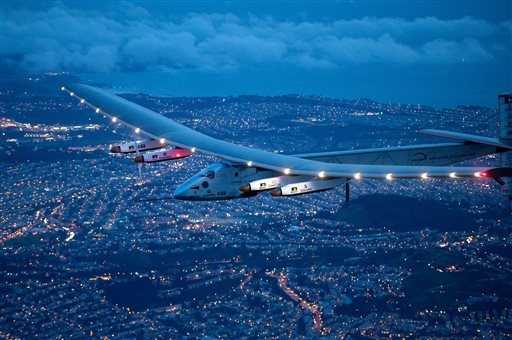
Flying across the Pacific Ocean in a fuel-less, solar-powered aircraft moving at 28 mph is a very arduous journey, requiring one remain alert for nearly three days straight. On Sunday, April 24, 2016, pilot Bertrand Piccard safely completed the 62-hour trip as he landed in Mountain View, San Francisco, Calif.

Piccard and fellow Swiss pilot Andre Borschberg have been taking turns flying the Solar Impulse 2 aircraft on an around the world tour since the plane first took off from Abu Dhabi, in March 2015. Within that time, the aircraft made stops in Oman, Myanmar, China, Japan, Hawaii, and now the west coast of the United States. The last leg of the journey was also the most dangerous, given the lack of emergency landings across the Pacific.
At 236 ft (72 meters) in length, the wingspan of Solar Impulse 2 surpasses that of a Boeing 747 by about 4 meters, but while the latter weighs nearly one million pounds, the Impulse 2 sits at 5010 pounds (2,300 kg), or roughly the same weight as a mid-sized Ford Fiesta. The aircraft is fabricated from carbon fiber composites that keep the weight down while providing enough structural stability to prevent its long wings from collapsing. These same wings are also coated with 17,248 solar cells, powering propellers which enable the craft to maintain a sustained flight speed of 28 mph for up to seven hours.

The biggest challenge Piccard faced in the three-day flight across the Pacific was actually keeping himself alert, as there were too many factors to contend with at any given point. Piccard slept in 20 minute intervals within the plane's one-person cockpit, relying on heating pads within his shoes and gloves to stay warm and meditation to stay focused.
“We have demonstrated it is feasible to fly many days, many nights, that the technology works,” said Borschberg, Piccard’s co-pilot who completed the Japan to Hawaii leg of the trip.
Solar Impulse 2 is scheduled to make three more stops before crossing over the Atlantic Ocean to Europe and Africa. The project began in 2002 and has since cost more than $100 million.
Source: Phys.org
Advertisement
Learn more about Electronic Products Magazine





